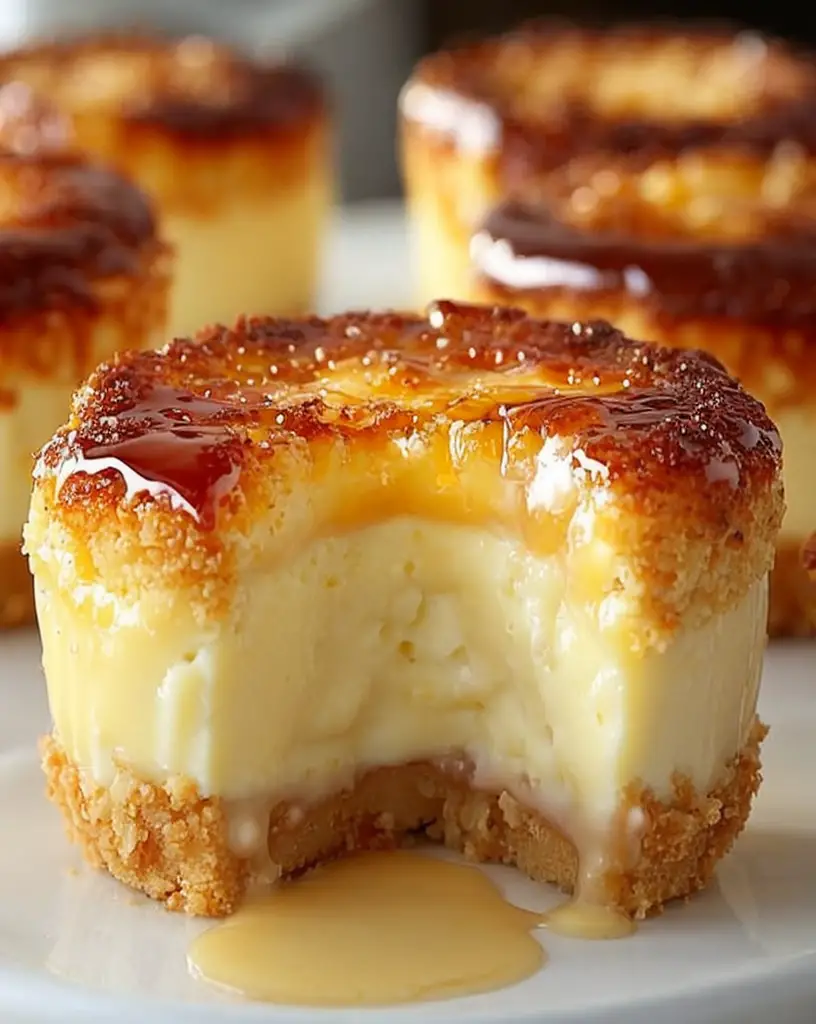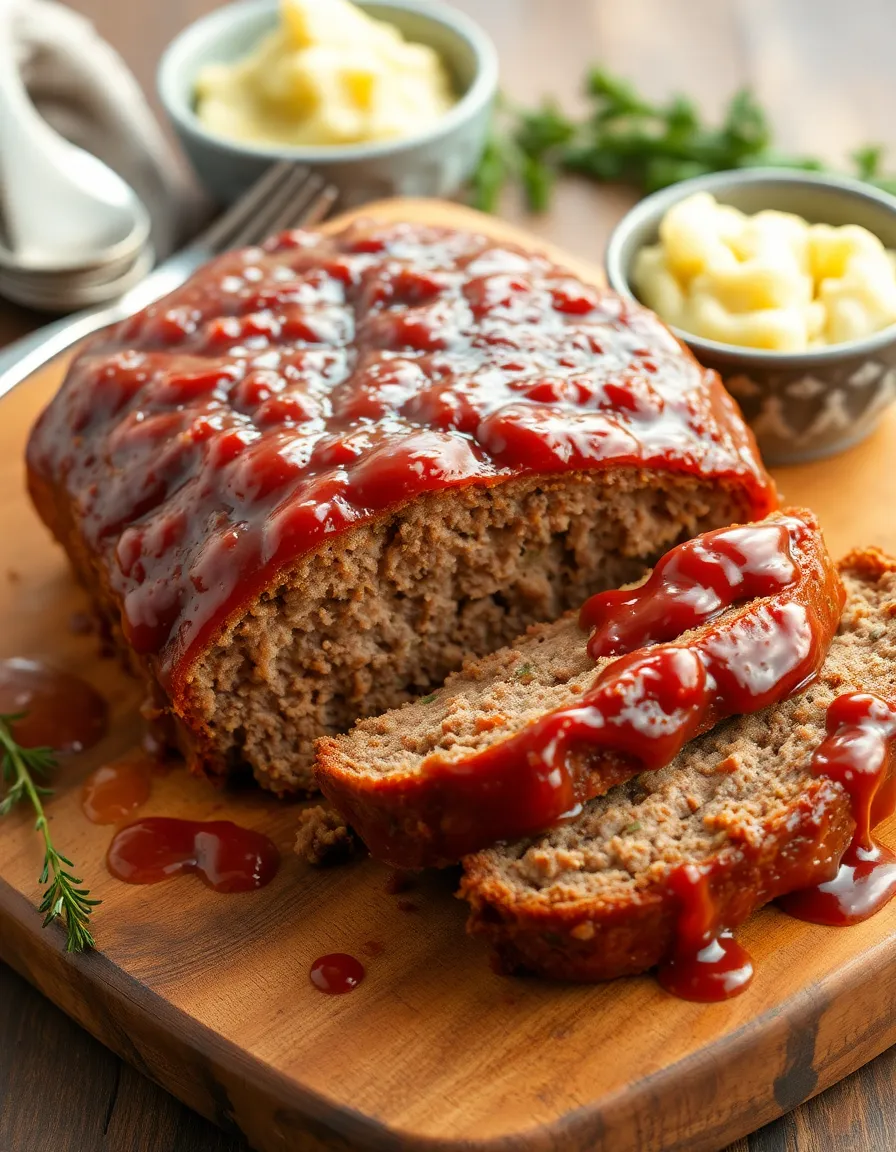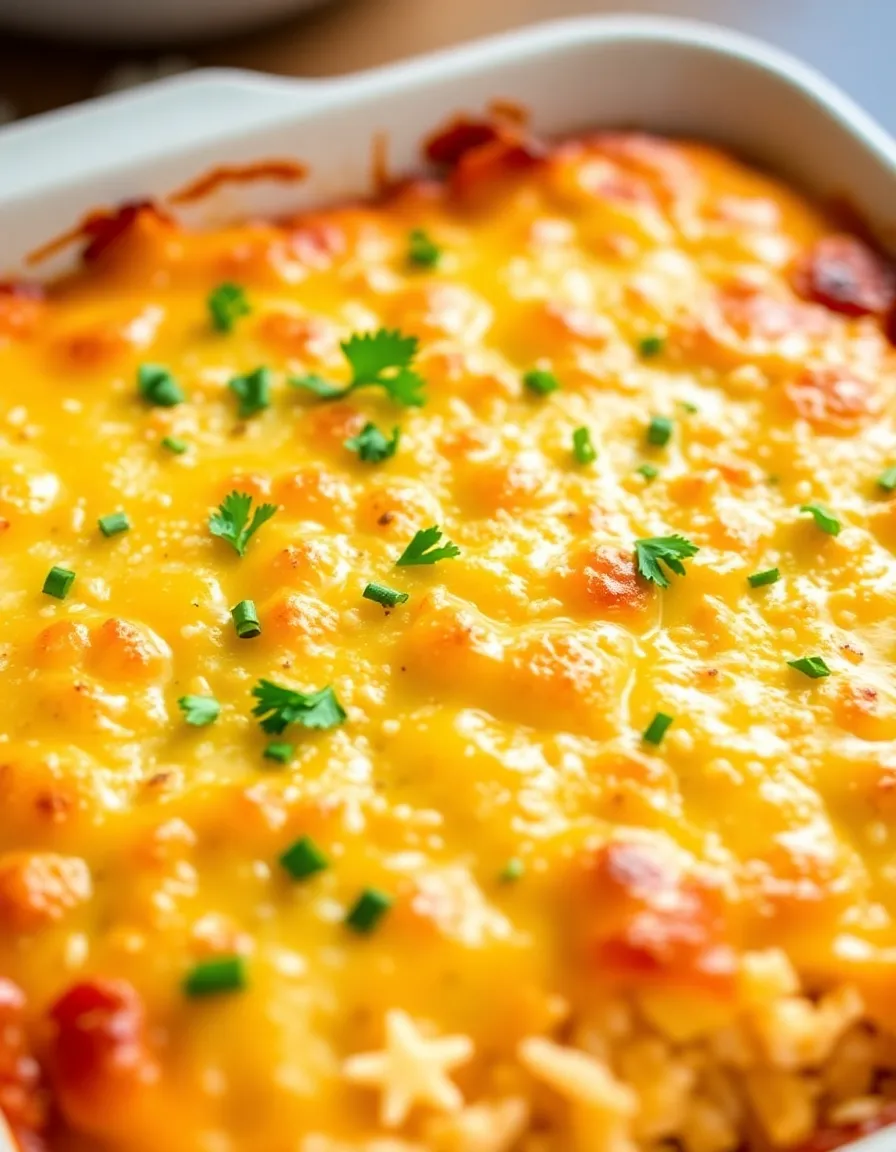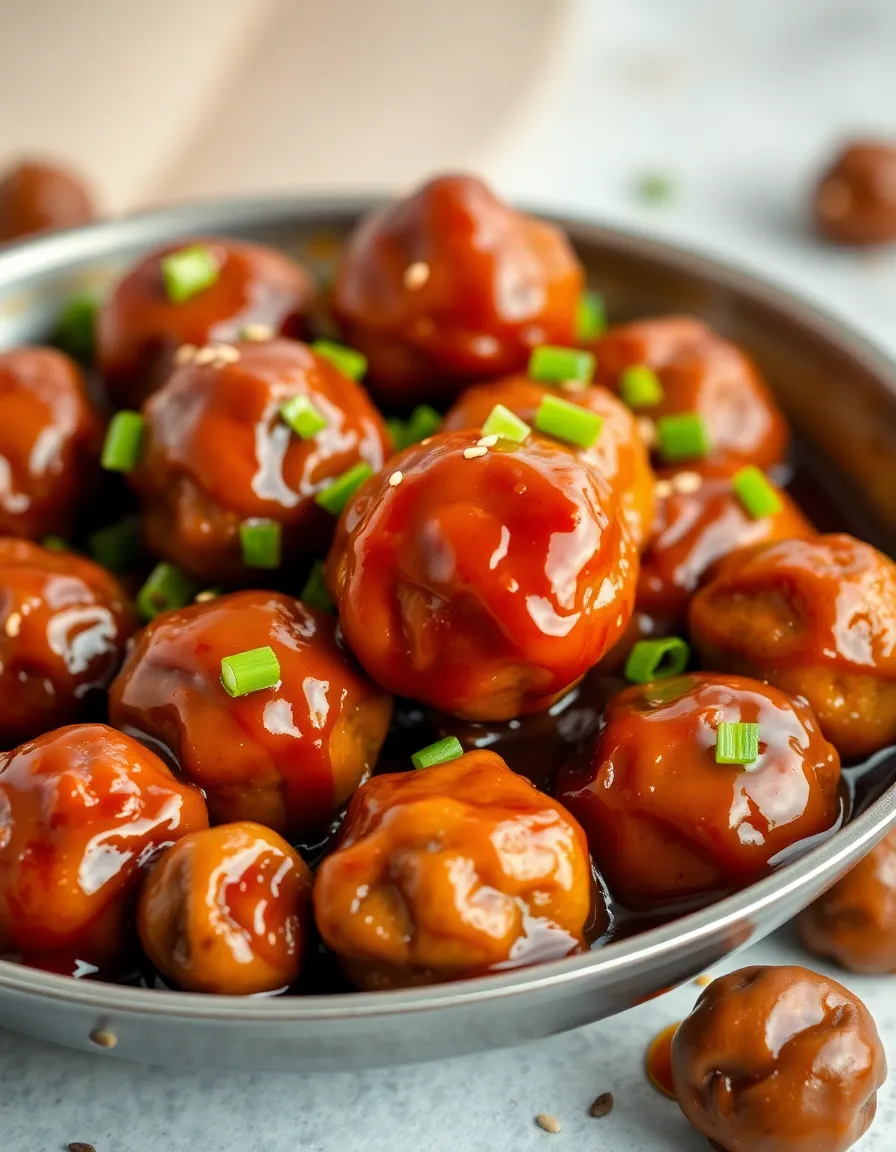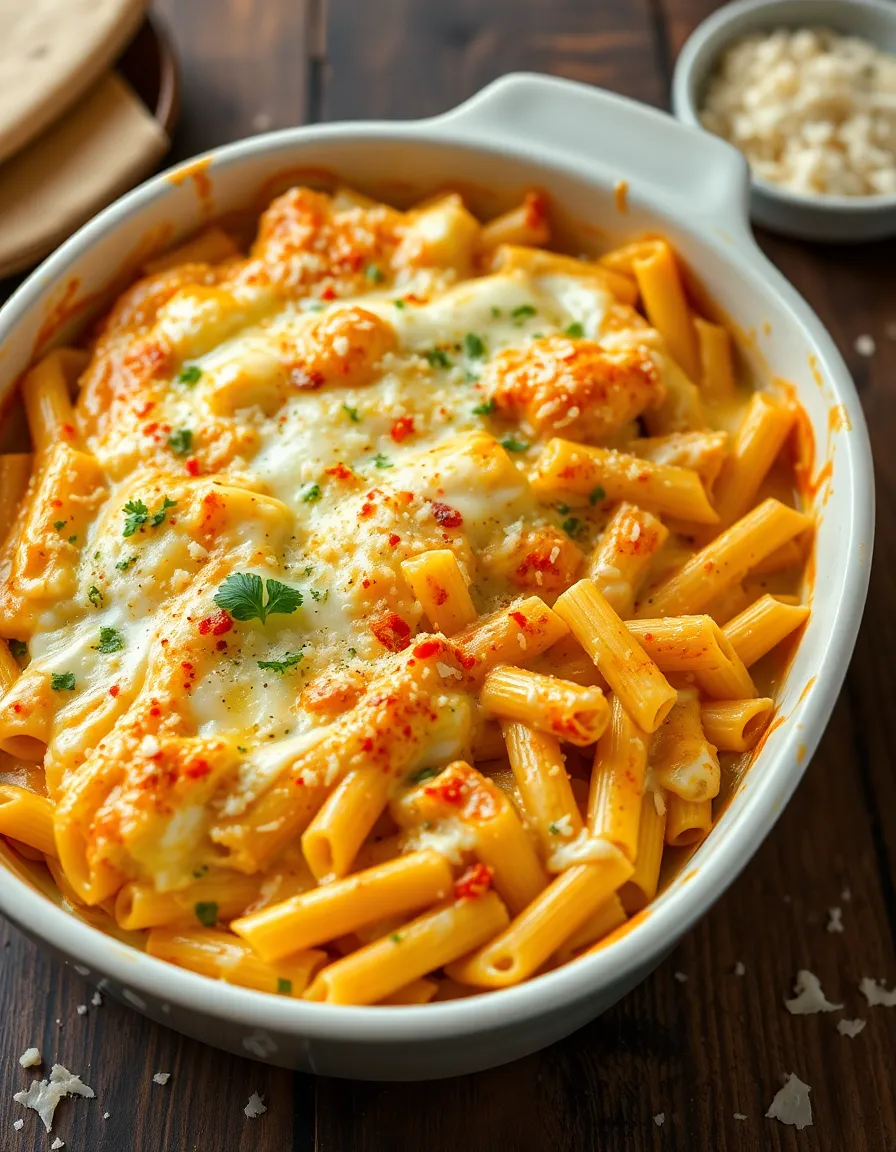Mini Crème Brûlée Cheesecakes Recipe: A Decadent Fusion
Imagine the rich, creamy elegance of crème brûlée now captured in a mini cheesecake. These Mini Crème Brûlée Cheesecakes beautifully blend the classic burnt sugar crust of crème brûlée with the smooth, tangy delight of cheesecake. With the balance of sweet vanilla notes and a hint of citrus, each bite feels like an indulgent escape. Served in individual portions, they offer a dazzling finish to any meal and are perfect for entertaining.
The allure of Mini Crème Brûlée Cheesecakes lies in their perfect textures and flavors. The creamy cheesecake layer melds harmoniously with the crispy caramelized sugar top, creating a symphony of contrasting yet complementary elements. Paired with a buttery graham cracker crust, they offer a reinvention of two dessert classics into one must-try creation. Whether for a fancy dinner party or a simple family gathering, these delightful treats will win hearts and please palates, giving a gourmet touch without the fuss of a full-size cheesecake.
Quick Recipe Highlights
- Flavor Profile: Delightfully creamy with a subtle tanginess from the cheesecake, elevated by the classic burnt sugar notes of crème brûlée.
- Texture: The cheesecake offers a smooth, velvety consistency, contrasted by the satisfyingly crisp sugar topping.
- Aroma: Expect a warm scent of vanilla and caramel when the sugar is torched, teasing the senses before the first bite.
- Visual Appeal: The golden-brown sugar crust creates a stunning contrast with the ivory cheesecake, making it as much a feast for the eyes as for the palate.
- Skill Level Needed: Intermediate, requiring basic cheesecake skills and a steady hand with a kitchen torch.
- Special Equipment: A kitchen torch for caramelizing the sugar on top is vital for achieving the signature look and taste.
Recipe Overview
- Difficulty Level: Moderately challenging as it combines techniques from both cheesecake and crème brûlée preparation, demanding attention to detail.
- Category: These cheesecakes fit perfectly into the dessert category but also serve as an excellent upscale snack or brunch item.
- Cuisine: A fusion of classic French and American techniques brings a global perspective to this beloved dessert combination.
- Cost: Relatively low-cost as basic ingredients like cream cheese and sugar are staples in most pantries, with moderate cost for special equipment like a torch.
- Season: Ideal for autumn through spring, capitalizing on the cozy, indulgent warmth these desserts offer.
- Occasion: Perfect for holidays, formal dinners, and celebrations, impressing guests with elegant presentation and sophisticated flavors.
Why You’ll Love This Recipe
The beauty of Mini Crème Brûlée Cheesecakes is in their complexity; they offer a blend of textures and flavors that tantalize every sense. Each mouthful provides a sumptuous creaminess balanced by the modest sharpness of the burnt sugar layer. This harmonious duality means there’s something new in every bite, making it impossible to resist.
These cheesecakes are not only a feast for the palate but also an exercise in convenience. The small, individual portions are effortlessly versatile, fitting in perfectly at any event, whether formal or casual. The preparation, although sophisticated, is straightforward with a few basic steps that yield professional results, making this dish a go-to for both seasoned cooks and newcomers.
Rich in calcium and protein thanks to the cream cheese base, these cheesecakes also offer nutritional benefits beyond simple indulgence. The inclusion of quality ingredients like vanilla and fresh lemon juice enhances the flavors naturally while keeping the dietary profile clean. An upgraded dessert with health-conscious leanings.
In social settings, Mini Crème Brûlée Cheesecakes can serve as conversation pieces. Their exquisite appearance mirrors a high level of culinary artistry, but with each bite, they break down the barriers of ordinary desserts, elevating any gathering. Guests are sure to remember the event where they sampled such a masterful creation.
Cost-effectiveness is another key advantage, as you can achieve bakery-level sophistication without the expense. Many ingredients are common staples, keeping the out-of-pocket expenditure low while still providing a luxurious experience. The easy access to ingredients and tools means these chic little desserts can be made on a whim, offering gourmet experience that won’t break the bank.
Historical Background and Cultural Significance
The origins of crème brûlée trace back to medieval Europe, with variations occurring across France, Spain, and England. As a hallmark of high-end French dining, its classic sugar crust has become synonymous with dessert elegance. Meanwhile, cheesecake’s history hails from ancient Greece and has been reinvented across countless cultures, resulting in the creamy, indulgent version beloved today.
Crème brûlée’s cultural importance lies in its representation of culinary refinement and tradition, symbolized by the rich custard and distinctive caramel top. On the other end, cheesecake represents comfort, tradition, and home-style baking. Over time, both desserts have carved their own unique niches, yet their convergence into one is a testament to creative culinary innovation.
The emergence of Mini Crème Brûlée Cheesecakes is a modern adaptation that combines the best of both worlds. While maintaining the cultural resonance of crème brûlée’s elegance, it taps into cheesecake’s approachability and comfort, forming a new tradition of its own. It showcases culinary evolution, inspired by age-old flavors yet crafted through contemporary techniques.
In various regions, you might find these desserts taking on different forms—some might prefer denser cheesecakes, while others play with the caramelization techniques. This regional diversity highlights the universal love for these flavors, yet each adaptation brings a unique twist, reflecting local tastes and preferences. Overall, these combined desserts celebrate global influences converging into delightful harmony.
Ingredient Deep Dive
Cream cheese, the cornerstone of any great cheesecake, hails from America with cultural associations tied to traditional American baking. Nutritionally, it provides ample amounts of calcium and beneficial fats. When selecting cream cheese, opt for full-fat versions for authenticity and richness. Store it in the refrigerator and use within a week of opening. If needed, mascarpone can serve as an indulgent substitute.
Eggs are pivotal in achieving the desired texture and structure, binding the cheesecake mixture while contributing to its silkiness. Free-range eggs are a good selection both for quality and ethics. Stored properly, eggs can last a few weeks in the fridge. In terms of substitution, for a lighter texture, whipped egg whites can replace some egg yolks.
Graham crackers form the base, offering texture and a sweet note that complements the creamy cheese layer. Key in American desserts, they add a nostalgic flavor profile. To maintain freshness, seal any unused crackers in an airtight container. For allergy concerns, almond meal can substitute to create a similar crust experience.
Granulated sugar is crucial for forming the brûlée effect. Look for fine-grain sugar, which melts evenly and produces a more cohesive caramel layer. It’s a pantry staple, durable and long-lasting, but ensure it remains in a dry, cool place to prevent clumping. For a healthier spin, raw sugar can replace white sugar; however, it may impact the caramelization process.
Vanilla takes the center stage in any crème brûlée, contributing depth and aromatic richness. Pure vanilla extract, sourced from high-quality beans, is ideal, adding authenticity to the flavor profile. Store vanilla extract in a dark, cool place to preserve its potency. A vanilla bean can replace extract by scraping out the seeds, resulting in an even more robust flavor.
Common Mistakes to Avoid
- Overbaking the cheesecake can lead to cracking. It’s essential to monitor the oven closely and remove the cakes while the centers are just set.
- Not cooling the cheesecakes sufficiently before adding sugar. This can compromise the integrity of the final brûlée layer, as residual heat may cause unwanted melting.
- Using cold cream cheese often results in a lumpy batter. Ensure cream cheese is softened to room temperature before blending.
- Inadequate sugar caramelization. Without a firm, even torch flame, the sugar may not caramelize, leading to less desirable texture and appearance.
- Ignoring the water bath during baking. This is vital for creating moist and evenly cooked cheesecakes, reducing the risk of drying out.
- Overmixing the batter can incorporate too much air, causing an uneven texture and possible cracking during baking.
- Skipping the rest time. Allowing cheesecakes to settle before serving enhances flavor integration and texture consistency.
- Inaccurately measuring ingredients, which affects the delicate balance of flavors and textures in the final product.
Essential Techniques
Baking in a water bath is crucial for preventing the cheesecake from drying out or cracking. This method ensures gentle and even heat distribution. Use a roasting pan filled with hot water, place your cheesecake pan inside, and let the oven do the gentle steaming.
Mastering the art of sugar caramelization with a torch creates the signature brûlée top. It’s important to move the flame evenly across the sugar layer to avoid burning. Look for uniform browning as your visual cue to stop. Consistency in sugar application also aids in achieving the ideal outcome.
Understanding the importance of precise ingredient measurements can’t be overstated. Baking is a science, and slight variances can drastically alter the end result. A kitchen scale can be invaluable here, ensuring each ingredient is added in the correct quantity.
Patience during cooling allows your cheesecake flavors to meld and the texture to stabilize. This cooling phase is as critical as baking, as it allows the cheesecakes to reach peak flavor intensity and ideal consistency.
When creating the crust, ensure even pressing into the muffin tins. Consistency in the base will support the cheesecake layer and prevent breaking or crumbling. Additionally, refrigerating the crust before adding the filling can enhance firmness and stability.
Pro Tips for Perfect Mini Crème Brûlée Cheesecakes
Start with room temperature ingredients to ensure a smooth and creamy filling—this is pivotal for avoiding lumps in the batter.
Use vanilla bean paste for an indulgent flavor profile. The specks of vanilla seeds add both aesthetic and taste enhancements.
To prevent cracking, avoid overbaking by checking the cheesecakes’ doneness through a gentle wobble test. A slight jiggle at the center indicates they’re ready to cool.
Experiment with different flavored sugars for the brûlée topping for a unique twist. Cinnamon or nutmeg-infused sugars can introduce a festive touch.
When using a kitchen torch, apply sugar evenly and use a steady back-and-forth motion. Allow the heat to do its work without rushing the caramelization process.
Opt for silicone baking cups for easy release and cleanup. They offer a seamless demoulding experience, preserving the presentation and structure of the cheesecakes.
To enhance the crust flavor, add a pinch of sea salt or a sprinkle of citrus zest mixed into the graham crackers, lifting the dessert profile.
Spray the cheesecake tops lightly with a bit of water right before scorching. It helps sugar adhere better and creates a smoother caramelization.
Variations and Adaptations
Regional variations might include using local sweeteners or flavorings, such as lavender sugar in Mediterranean adaptations or coconut sugar in tropical regions, which can subtly change the dessert’s profile.
Seasonal adaptations may incorporate flavors such as pumpkin spice for autumn or lemon zest for spring, reflecting the best in seasonal produce and captivating the palate with fresh accents.
For dietary modifications, consider replacing dairy products with plant-based alternatives, such as coconut cream cheese and almond milk, allowing those who are lactose intolerant to indulge.
Enhance the flavor with add-ins like espresso powder for a mocha touch, or incorporate fruit, such as raspberries, into the batter for a tart counterpoint.
Adjust the texture by playing with cream cheese and mascarpone ratios, creating a denser or lighter texture according to preference; or add gelatin if a firmer cheesecake is desired.
Presentation alternatives may include serving on decorative platters or in ramekins for a classic look. Use edible flowers for garnish or present with sprigs of fresh mint to add visual dimension.
Serving and Presentation Guide
For an elegant presentation, place each cheesecake on individual dessert plates. Decorate with a light dusting of powdered sugar around the plate for an attractive border. Consider using a stencil for patterns.
Innovate with garnishing ideas by adding fresh berries, the balance of tart and sweet juxtaposing the cheesecake’s rich creaminess. A dollop of whipped cream can add height and sophistication.
Traditional accompaniments such as tempered chocolate shavings or a spoonful of berry compote elevate the dish and provide additional texture contrast.
For modern serving suggestions, consider serving directly from the mold on individual dessert boards with playfully arranged garnishments.
Serve slightly chilled to maintain textural integrity, ensuring the caramelized sugar remains crisp while the creamy center softens beautifully on the tongue.
When sizing portions, ensure a balance by serving with delicate cutlery—smaller utensils can encourage slower, more mindful eating, allowing guests to savor the flavor profile fully.
Wine and Beverage Pairing
Pair these cheesecakes with a late-harvest Riesling or Moscato d’Asti, whose honeyed notes and slight acidity complement the dessert’s rich texture and burnt-sugar top.
For non-alcoholic alternatives, consider sparkling apple cider, offering a crisp, fruity counterbalance. Herbal teas such as chamomile and vanilla infusions present soothing, aromatic partnerships.
A rich espresso or creamy cappuccino can enhance the dessert experience, its deep roast acting as a bold contrast to the cheesecake’s sweetness while uplifting the sensory notes.
Consideration for beverage temperature is crucial, as slightly cooler drinks proffer optimal flavor impact when matched with these chilled desserts. Do not underestimate the importance of terroir in wine pairings, which can accentuate particular flavor dimensions.
Serve beverages in either stemmed glasses or polished ceramic cups to harmonize with the cheesecakes, adding a touch of elegance and refinement to the overall presentation.
Storage and Shelf Life
To store, place cheesecakes in an airtight container and refrigerate promptly after cooling. They remain optimal for about three to five days. Consider wax paper layers between cheesecakes to protect the delicate tops.
Ensure they’re kept below 40°F (4°C) to maintain freshness, as maintaining appropriate temperatures is pivotal for food safety.
Choose containers that allow minimal air exposure to prevent drying out. Ideal options are silicone-sealed glass containers or well-sealed plastic storage solutions.
Signs of spoilage include any off-odors or visible mold, indicating extended storage beyond recommended limits.
Reheat gently if desired, preferably without the crust, using short microwave bursts or a warm oven. However, these cheesecakes are typically enjoyed chilled, retaining original taste profiles.
For freezing, wrap tightly in plastic and foil to prevent freezer burn, suitable for up to one month. Thaw overnight in the refrigerator before serving, complementing reheating techniques.
Make Ahead Strategies
Creating a make-ahead plan reduces day-of stress. Prepare the crust and filling separately in advance, storing them until baking day to streamline your workflow.
Chill the unbaked crust for at least an hour to ensure optimal adherence, allowing effortless filling addition during assembly.
Quality impacts are minimal with advance preparation, as flavors continue to meld beautifully. Some say a day of resting enhances the sensory experience, providing a deeper, richer flavor profile.
During assembly, maintain neat edges for a polished look. Consider using a spatula for even distribution and air pocket removal.
Reheat the final dessert at room temperature, avoiding direct heat sources to preserve texture. Complement with freshly prepared garnishes for vibrant visual appeal.
If serving fresh fruit, add just before presentation to keep vibrant. Whipped cream should be added immediately preceding serving, retaining peak texture and stability.
Scaling Instructions
To halve the recipe, precise measurement adjustments are required for ingredients, especially baking powder and leavening agents, ensuring consistency.
When doubling or tripling, note that oven times may extend as more material retains heat longer. Partition into smaller baking sessions if needed for consistency.
Equipment adjustments include larger mixing bowls and additional baking tins or springs to accommodate extra quantities without overloading tools.
Timing modifications entail staggered bakes if using a single oven, avoiding overfilling that may interfere with necessary airflow around tins.
Storage accommodations require additional containers, ensuring all finished products remain uniformly protected in large quantities, maintaining optimal conditions.
Nutritional Deep Dive
A macro breakdown reveals a high-fat profile courtesy of cream cheese, providing energy density while balancing with moderate protein levels.
The micronutrient analysis emphasizes calcium and vitamin A contributions from dairy ingredients, offering structural benefits and antioxidant properties.
Health benefits include the presence of essential amino acids, assisting recovery and body maintenance. The strategic use of sugars and fats aligns with moderate-dessert consumption goals.
Dietary considerations focus on portion control, especially in calorie-dense desserts, aligning with overall meal balance exclusions or substitutions.
Portion analysis highlights the importance of mindful consumption, savoring smaller amounts which align with health guidelines yet maintain titillating culinary enjoyment.
Weight management tips regard these desserts as an occasional treat, integrating flavorful satisfaction into a balanced, moderated diet without surplus guilt.
Dietary Adaptations
For gluten-free adaptations, replace graham crackers with a gluten-free alternative like almond or coconut flour crusts, retaining texture and taste.
A dairy-free approach includes subbing plant-based cream cheese such as almond or cashew blends, matching consistency and flavor.
For vegan versions, combine non-dairy alternatives with flaxseed or blended tofu for structure, omitting traditional egg and dairy ingredients.
Low-carb iterations exclude processed sugars for natural substitutes like stevia or erythritol, using almond meal crusts for complementary profiles.
Keto-compliant options adjust sweeteners further, alongside additional fats like coconut oil or avocado puree for helps target macronutrient ratios effectively.
Paleo adaptations focus on whole-food ingredients, minimizing processed components, using raw honey or agave as sweetness sources.
For a low-FODMAP solution, use lactose-free cheeses and alternative bases, monitoring irritative sweeteners that align with dietary needs.
The Recipe
Mini Crème Brûlée Cheesecakes
Serves: 12
Prep Time: 20 mins
Cook Time: 35 mins
Total Time: 55 mins
Kitchen Equipment Needed
- Muffin tin
- Mixing bowls
- Electric mixer
- Kitchen torch
- Cooling rack
Ingredients
- 1 cup graham cracker crumbs
- 2 tbsp melted butter
- 16 oz (2 packages) cream cheese, softened
- 1/2 cup granulated sugar, plus more for topping
- 1 tsp vanilla extract
- 2 large eggs
- 1/4 cup heavy cream
- 1 tbsp lemon juice
Directions
- Preheat oven to 325°F (165°C) and line a muffin tin with baking cups.
- Combine graham cracker crumbs and melted butter, pressing the mixture into the base of each muffin cup.
- In a mixing bowl, beat cream cheese until creamy, then add sugar and blend well.
- Mix in vanilla, then add eggs one at a time, mixing until just combined.
- Stir in heavy cream and lemon juice, distributing into the prepared crusts evenly.
- Bake for 20-23 minutes until centers are set. Cool at room temperature, then refrigerate for at least 2 hours.
- Before serving, sprinkle sugar on tops and caramelize with a kitchen torch until golden. Allow to cool briefly, then enjoy!
Recipe Notes
- Ensure even sugar topping for consistent caramelization.
- Serving suggestion: Top with seasonal berries or a dollop of cream.
- Use a water bath to prevent cracks and ensure moist texture.
Troubleshooting Guide
- If cracks appear on the surface, ensure a gentle bake with temperted heating; a water bath helps maintain moisture levels and avoid this.
- If sugar crystallizes instead of caramelizing, make sure to apply the torch evenly and swiftly across the surface for uniform melting.
- For grainy textures, ensure cream cheese is at room temperature before mixing to prevent over-beating.
- If crust crumbles, be sure to press firmly and chill before filling, allowing cohesive setting.
- A burnt sugar topping may result from torching too closely—maintaining distance gives more control over even caramelization.
- Stubborn sticking to muffin tins suggests inadequate greasing; use baking cups to simplify removal.
- Flavor imbalance may arise if using low-quality vanilla—opt for pure extract for best results.
- Excessively dense cheesecakes indicate overmixing, incorporate ingredients until just combined for optimal texture.
Recipe Success Stories
Crafted from personal inspiration or social outings, this Mini Crème Brûlée Cheesecake recipe has become a celebrated staple among many culinary enthusiasts. Sharing the joy, followers have tried incorporating unique local flavors like bourbon or orange zest to offer personalized variations that honor the core recipe.
Community feedback sings praises of the harmonious textural contrast, with numerous testimonials highlighting successful dinner parties where these desserts captivated the spotlight. This reinforces the belief that the combination of cheesecake richness with brûlée sophistication resonates with diverse palates.
Inventive adaptations frequently appear, such as chai-spiced toppings or even alcohol-infused custard layers. Engaging discussions around such ideas foster collaboration, encouraging continued veneration and evolution of the dessert.
Enthusiastic readers often share cherished photographs documenting their masterpiece creations, fueled by vibrant social platform interactions. These inquisitive engagements offer real-time suggestions, helping expand on creative culinary horizons.
Engagement succeeds into the everyday kitchen, with informative photography tips shared making the crafting process as visually rewarding as the end product itself. Capturing not just food, but moments of shared pleasure, sustains enthusiasm across varying food lover communities.
Frequently Asked Questions
Can I make this recipe without a kitchen torch? Yes, use the oven broiler as an alternative, though it requires close monitoring to avoid burning.
Is it possible to prepare these cheesecakes in advance? Absolutely, they actually benefit from an overnight chill, deepening flavors.
What if I don’t have graham crackers? Digestive biscuits or almond meal can serve as good substitutes for the crust.
How can I avoid cracks on the cheesecake? Utilize a water bath during baking and avoid overmixing to maintain the perfect texture.
Are there kid-friendly variations of this recipe? Yes, consider omitting the sugar topping, reducing potential hazards with the torch.
Can mascarpone be used instead of cream cheese? Yes, it offers a creamier finish, though it alters the traditional flavor slightly.
Is gelatin necessary for setting? Not typically; follow the recipe’s ratios and procedures for natural setting without it.
What is the shelf life of finished cheesecakes? Stored correctly, they last up to five days refrigerated and can freeze up to one month.
Do these cheesecakes need to be served warm? Serve chilled for optimal texture and flavor; briefly torch prior to serving for crispy sugar crust.
Are there vegan alternatives available? Yes, vegan cream cheese and egg replacements such as aquafaba can be substituted into the base recipe.
Can I make this recipe gluten-free? Absolutely, simply use a gluten-free crumb base like almond meal instead of graham crackers.
What wine pairs well with this dessert? Pair with light, fruity wines such as Moscato for complementary enhancement, offering balanced acidity and flavor complexity.
Additional Resources
For those seeking further inspiration, related recipes like traditional French Crème Brûlée or classic New York Cheesecake provide foundational practice.
Technique guides addressing topics such as water bath utilization or sugar caramelization can refine precision, ensuring flawless execution.
Ingredient deep dives explore the role and variations of key constituents, expanding your culinary knowledge and palette.
Equipment recommendations focus on obtaining and utilizing optimal tools, ensuring comprehensive preparedness in crafting high-quality desserts.
Seasonal variations offer a breadth of possibilities, ensuring recipes remain fresh and exciting across the calendar.
Join the Conversation
Engage with us by sharing your creations on social media, where we’d love to highlight your version of Mini Crème Brûlée Cheesecakes.
Photography tips enhance the presentation, elevating your culinary accomplishments to visually arresting impressions.
Providing straightforward recipe reviews encourages community discourse, spreading constructive feedback within a supportive venue.
Feel empowered to suggest tweaks or alternate flavors, celebrating diverse perspectives and innovative adaptations as they arise.
Together, let’s build an engaging platform where these desserts spark joy, inspiring continuous creation and sharing among a vibrant culinary community.

